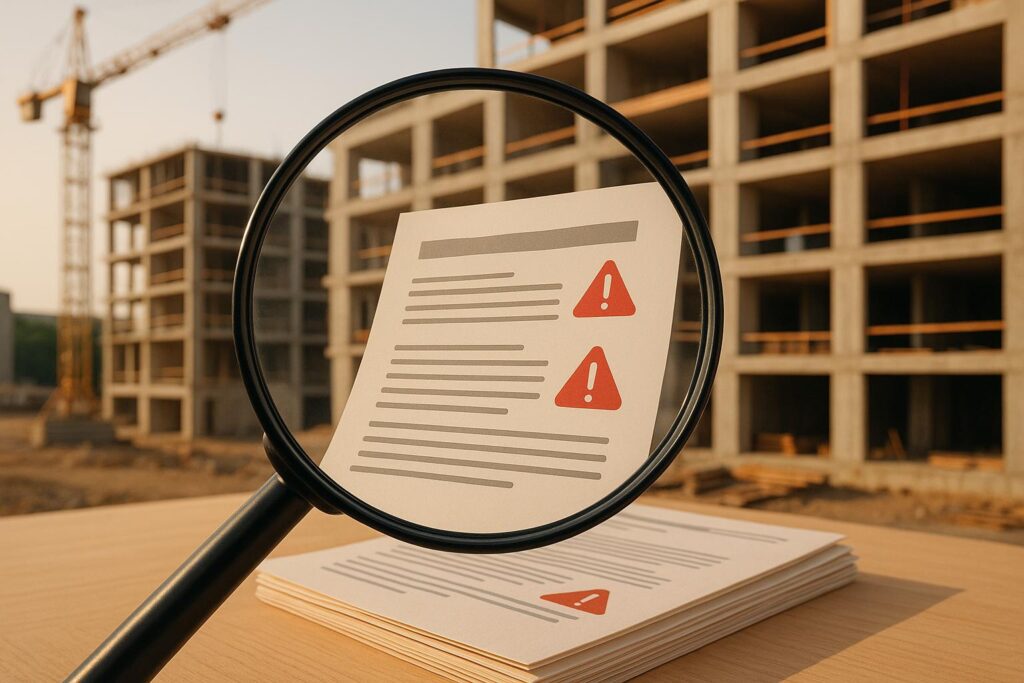Fraud in the construction industry is a growing concern, with cases increasing by 60% according to recent findings. This rise is linked to economic pressures, complex project structures, and evolving digital threats. Fraud schemes such as inflated payment applications, document forgery, and material theft are causing significant financial losses for companies and stakeholders. Additionally, advancements in AI and digital tools have introduced sophisticated tactics like AI-powered forgeries and virtual fraud, further complicating detection efforts.
Key takeaways:
- Common fraud types: False payment claims, forged documents, and material theft/substitution.
- Emerging threats: AI-driven forgery and remote fraud risks.
- Financial impact: Increased insurance premiums and penalties for fraud.
- Prevention strategies: Invoice verification, on-site inspections, and advanced analytics tools.
Construction Fraud Detection: AI Identifies Discrepancies and Prevents Abuse! Part 1 #ai #viral
Common Fraud Schemes in Construction Claims
Fraud in the construction industry often takes advantage of the sector’s intricate payment systems and reliance on extensive documentation. By understanding these schemes, businesses can spot red flags early and potentially avoid major financial setbacks. Below, we break down three common schemes: false payment applications, document forgery, and material theft or substitution.
False or Inflated Payment Applications
This type of fraud involves manipulating payment requests to extract funds dishonestly. Here are the main tactics:
- Billing for unperformed work: Fraudsters exploit milestone payment systems by invoicing for tasks that haven’t been completed.
- Cost inflation: Labor hours, material quantities, and equipment usage are exaggerated. This can involve falsified timesheets, misrepresented material grades, or overstated rental durations.
- Change order manipulation: Routine project adjustments are misused by contractors who inflate or fabricate change orders, increasing costs without delivering additional value.
- Progress payment fraud: Contractors overstate how much work has been completed to secure payments earlier than justified. This delays the actual performance while accelerating cash flow to the fraudster.
Document Forgery and Misrepresentation
Fraudsters often manipulate or fabricate documents to mislead stakeholders. Common examples include:
- Invoice and receipt falsification: Using forged supplier invoices, fake subcontractor bills, or altered documents to inflate costs. Modern software tools make these forgeries increasingly convincing.
- Certification and inspection fraud: Contractors may forge inspection reports, safety compliance documents, or material certifications to bypass quality control processes. This not only cuts corners but also introduces safety risks and potential liabilities.
- Lien waiver manipulation: Submitting false lien waivers to falsely claim that subcontractors and suppliers have been paid, allowing fraudsters to collect progress payments improperly.
- AI-enabled digital tampering: Advanced technology is used to alter contracts, specifications, or correspondence, either to inflate claims or hide non-compliance with project standards.
Theft and Substitution of Materials
Material-related fraud schemes can cause significant financial and operational disruptions. Key examples include:
- Direct material theft: Materials, tools, or equipment are stolen from job sites, often for personal use or resale. Recovery rates for stolen items are typically low.
- Material substitution: Lower-quality materials are used in place of those specified in the contract. This undermines the project’s quality and structural integrity while generating illicit profits.
- Phantom delivery fraud: Suppliers bill for materials that were never delivered or exaggerate the quantities provided. This often involves collusion with on-site personnel who falsify delivery receipts or inventory records.
- Surplus material diversion: Excess materials are ordered and then redirected for other purposes, with the original project being billed for the full amount.
- Equipment rental fraud: Fraudulent billing for equipment that was never delivered, extended rental periods that exceed actual use, or inflated rates for standard equipment. In some cases, fake rental companies are set up solely to issue bogus invoices.
Fraudsters often combine multiple schemes to maximize their gains, making detection even more difficult. The involvement of numerous stakeholders and the complexity of payment systems in construction projects create ample opportunities for exploitation. Understanding these tactics is the first step in safeguarding against them.
Financial Impact of Construction Claims Fraud
The construction industry has faced a sharp rise in fraudulent claims, with a 24% increase in losses tied to asset mismanagement, deceit, and false reporting during the pandemic. This spike has sent shockwaves through the sector, affecting everything from project budgets to insurance costs.
One major consequence of these fraudulent activities is the escalation of insurance premiums. Practices like "ghost claims" have placed additional financial strain on construction projects, further stretching already tight budgets.
Regulatory data from the past year reveals the financial consequences for those caught engaging in fraud. Penalties range from fines between $1,500 and $2,500 to suspensions for breaches of integrity. These outcomes highlight the pressing need for effective fraud detection and prevention strategies to protect the industry’s financial health.
New Fraud Trends and Technology Risks
The construction industry is facing a new wave of fraud risks fueled by advancements in digital tools. These risks are distinct from traditional methods, highlighting the need for updated prevention strategies and stronger verification systems. As technology evolves, so do the tactics used by fraudsters, making it essential to stay ahead with modern security measures.
AI-Driven Document Forgery and Identity Theft
Artificial intelligence has brought significant improvements to project management, but it also opens the door to sophisticated fraud. AI-powered tools can now create fake documents and manipulate identities, making it harder to verify records and credentials. Unlike traditional forgery, these advanced methods demand innovative detection techniques to safeguard against misuse.
Remote and Virtual Fraud Tactics
The shift to remote work and reliance on digital platforms has introduced new vulnerabilities. Construction firms increasingly depend on online communication tools and virtual meetings, which can be targeted by unauthorized access and impersonation. Additionally, the widespread use of mobile apps and other digital solutions for project management and payment processing raises concerns about data breaches and transaction security. Strong cybersecurity measures are critical to protecting sensitive information and ensuring safe operations in this digital landscape.
sbb-itb-2d170b0
Fraud Detection and Prevention Methods
Construction companies need robust, multi-layered systems to spot suspicious activities and address fraudulent claims before they escalate.
Verification of Invoices and Payment Applications
A meticulous review of documentation is a cornerstone of fraud prevention. Construction companies should implement strict protocols to cross-check invoices against purchase orders, delivery receipts, and project timelines. This ensures that every payment request aligns with actual project activities.
On-site inspections are equally important to combat material substitution fraud. Regular visits help confirm that the materials delivered match the invoices in terms of brand, specifications, and quantities.
Digital audit trails provide a transparent record of every transaction. Using management software, companies can track unusual patterns, such as invoices submitted outside normal business hours or payment requests that significantly exceed project budgets. These systems can flag inconsistencies or mismatched vendor details, alerting managers to potential fraud.
Vendor verification is another critical step. By maintaining up-to-date contractor licenses, insurance certificates, and business registrations, companies can prevent fraudsters from using expired or fake credentials to submit false claims.
These verification measures lay the groundwork for incorporating advanced tools that take fraud detection to the next level.
Advanced Analytics and AI Tools
Pattern recognition software analyzes historical payment data to uncover anomalies that might escape human notice. For example, if the cost of concrete unexpectedly jumps 40% without any market justification, the system flags it for further investigation.
Automated document analysis uses machine learning to detect even subtle signs of tampering, such as altered invoices or AI-generated forgeries. These tools are especially effective in identifying sophisticated fraud that traditional reviews might overlook.
Predictive analytics assigns risk scores to vendors and projects by evaluating factors like payment history, project complexity, and vendor reliability. This helps companies anticipate potential fraud risks and take preemptive action.
Real-time monitoring offers immediate oversight of expenses, allowing companies to detect fraudulent activities within days rather than weeks or months.
While these advanced tools strengthen internal controls, specialized insurance support adds an extra layer of protection.
Support from Accounts Receivable Insurance
Risk assessment services provided by Accounts Receivable Insurance (ARI) help identify vulnerabilities early. By analyzing client payment histories, financial stability, and industry-specific fraud trends, ARI develops customized strategies to mitigate risks.
Claims management support ensures that any suspicious activities are thoroughly investigated. ARI also coordinates with law enforcement when necessary, helping companies recover as much as possible from fraudulent losses.
Pre-claim interventions act quickly to stop potential fraud in its tracks. This could involve enhanced verification processes for specific clients or temporary payment holds while investigations are conducted.
Customized policy design ensures that construction companies get coverage tailored to their unique needs. ARI works with companies to address specific fraud risks, ensuring they pay only for relevant coverage while maintaining strong protection where it matters most.
Conclusion and Key Takeaways
The construction industry ranks as the fourth most vulnerable to fraud, according to recent studies. This highlights how critical it is for businesses in this sector to adopt effective measures to reduce risk.
A strong approach to fraud prevention combines solid internal controls with focused risk management strategies. One such solution is Accounts Receivable Insurance, which offers customized trade credit and receivables protection. This type of coverage helps businesses guard against fraud by incorporating advanced detection tools and preventative measures, ensuring construction operations remain secure and resilient.
FAQs
What steps can construction companies take to detect and prevent AI-driven fraud in their projects?
Construction companies can tackle AI-driven fraud by leveraging smart fraud detection tools powered by artificial intelligence. These tools are designed to scan digital documents for inconsistencies or signs of tampering, flagging potential issues instantly. This proactive approach helps stop fraudulent activities before they gain traction.
On top of that, integrating biometric verification systems – like fingerprint scanning or facial recognition – provides an added layer of security. Keeping a close eye on digital interactions and tracking unusual activity is also crucial for identifying suspicious behavior early. By combining these strategies, construction companies can better safeguard their projects and reduce the risk of digital fraud.
How can construction companies prevent fraud and reduce its impact on their insurance costs and project budgets?
Construction companies can take meaningful steps to prevent fraud and lessen its financial impact. Key measures include implementing robust internal controls, conducting regular audits, and offering fraud awareness training to employees. These practices make it easier to catch potential issues early, reducing overall risk.
On top of that, having a clear code of ethics, closely tracking project expenses, and maintaining detailed records for all transactions can provide an extra layer of protection. By staying ahead of potential fraud, companies not only safeguard their project budgets but may also keep insurance costs in check by lowering the chances of fraudulent claims.
How do advanced analytics and AI tools help identify fraud in construction claims?
The Role of Advanced Analytics and AI in Detecting Fraud in Construction Claims
Advanced analytics and AI tools are transforming how fraud is detected in construction claims by swiftly identifying unusual patterns and highlighting potential red flags. These technologies excel at handling vast amounts of claim data, pinpointing inconsistencies or anomalies that might escape human attention.
In addition to their analytical capabilities, AI automates routine investigative tasks. This frees up human analysts to tackle more complex cases, boosting efficiency while improving the precision of fraud detection. By leveraging these tools, businesses can minimize financial losses and address fraudulent activities with greater effectiveness.




